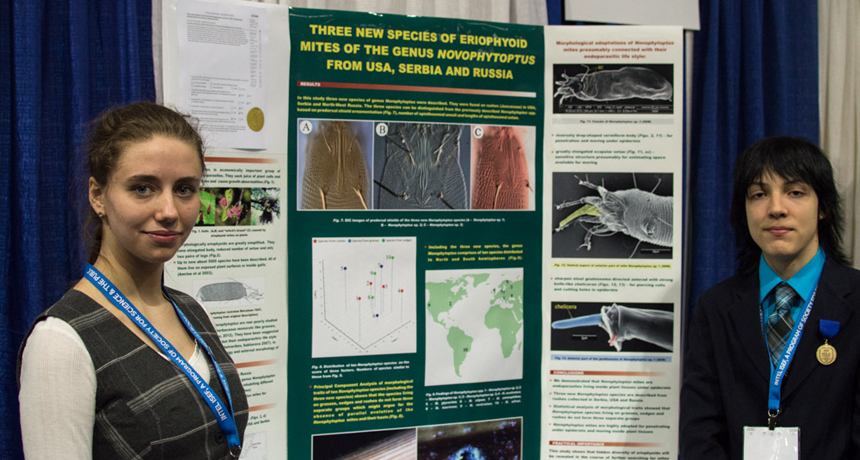Mite-y discoveries!
Two Russian teens discovered three species of mites new to science

Valentina Ruazantceva, 16, and Timofei Petrushenko, also 16, of the Academic Gymnasium of Saint-Petersburg State University in Saint Petersburg, Russia, discovered three new species. Each is a type of mite that attacks plants.
Patrick Thornton/SSP
By Sid Perkins
LOS ANGELES — It is exciting to discover a species of animal or plant that is new to science. Now, imagine finding three new animal species. That’s what two Russian teens achieved as they were searching through vegetation, looking for mites.
Mites are tiny. Most can be seen only with the aid of a microscope. As arachnids, they belong to the group of animals that includes spiders, scorpions and ticks. Like ticks, their closest relatives, many mites are parasites. That means that they get their nutrition by taking advantage of their plant or animal hosts.
This is especially true for a group of mites called eriophyoid (ERR-ee-oh-FEE-oid) mites. And because mites in this group live inside plants — and outside of view — they have not been well studied, says Timofei Petrushenko, 16. He’s a 10th-grade student at the Academic Gymnasium of Saint-Petersburg State University in Saint Petersburg, Russia.
Though poorly known, eriophyoid mites could be very important. They spread from plant to plant by riding the winds. They can cause abnormal growths on the plants they infect. These mites also can ferry viruses from one plant to another. That could cause big problems for crop species hosting the mites, Timofei told Science News for Students.
He and classmate Valentina Ruazantceva, also 16, collected samples of grass-like plants called rushes. These were growing near their homes in northwestern Russia. They also asked a Russian scientist for samples of similar plants from other parts of the world. Then, Timofei and Valentina looked at the samples closely.
In particular, the teens pored over parts of the plants that were discolored. With tiny needles, they probed the plants in those areas, removing samples from inside them. They also searched discolored stems for tiny holes. Holes could signal where mites had bored through to get inside the plants.
During their research, Timofei and Valentina found three new species of mites. One came from the plants the teens collected near their homes. The other two came from plant samples collected in the United States and Serbia.
The teens described their findings to judges here last week as finalists at the International Science and Engineering Fair, or ISEF. The competition was created by Society for Science & the Public and is sponsored by Intel. Each year, Intel ISEF showcases some of the best high school science projects from around the globe. (SSP also publishes Science News for Students.)
Like previously known species of eriophyoid mites, each of the three new ones has only two pairs of legs. (Many mites, especially those that live on the outside of animals or plants, have eight legs.) Distinctive patterns of ridges and grooves on the new mites’ bodies aren’t like those found on other species. That’s a sign that the teens have turned up species new to science, explains Timofei.
The teens plan to submit a scientific paper describing their findings to Zootaxa. It’s a journal where scientists describe details of newfound animal species, notes Valentina. If the paper is accepted by the journal — and the mites confirmed to be novel species — these teens may get to choose the scientific names for each one. How cool is that?
Power words
arachnid A group of invertebrate animals that includes spiders, scorpions, mites and ticks. Many have silk or poison glands.
mite An invertebrate belonging to the broad group of animals known as arachnids, which also include spiders and ticks. None of these are insects, although like insects they belong to the larger umbrella group called arthropods (named for their members’ segmented legs).
parasite An organism that gets benefits from another species, called a host, but doesn’t provide it any benefits. Classic examples of parasites include ticks, fleas and tapeworms.
species A group of similar organisms capable of producing offspring that can survive and reproduce.







